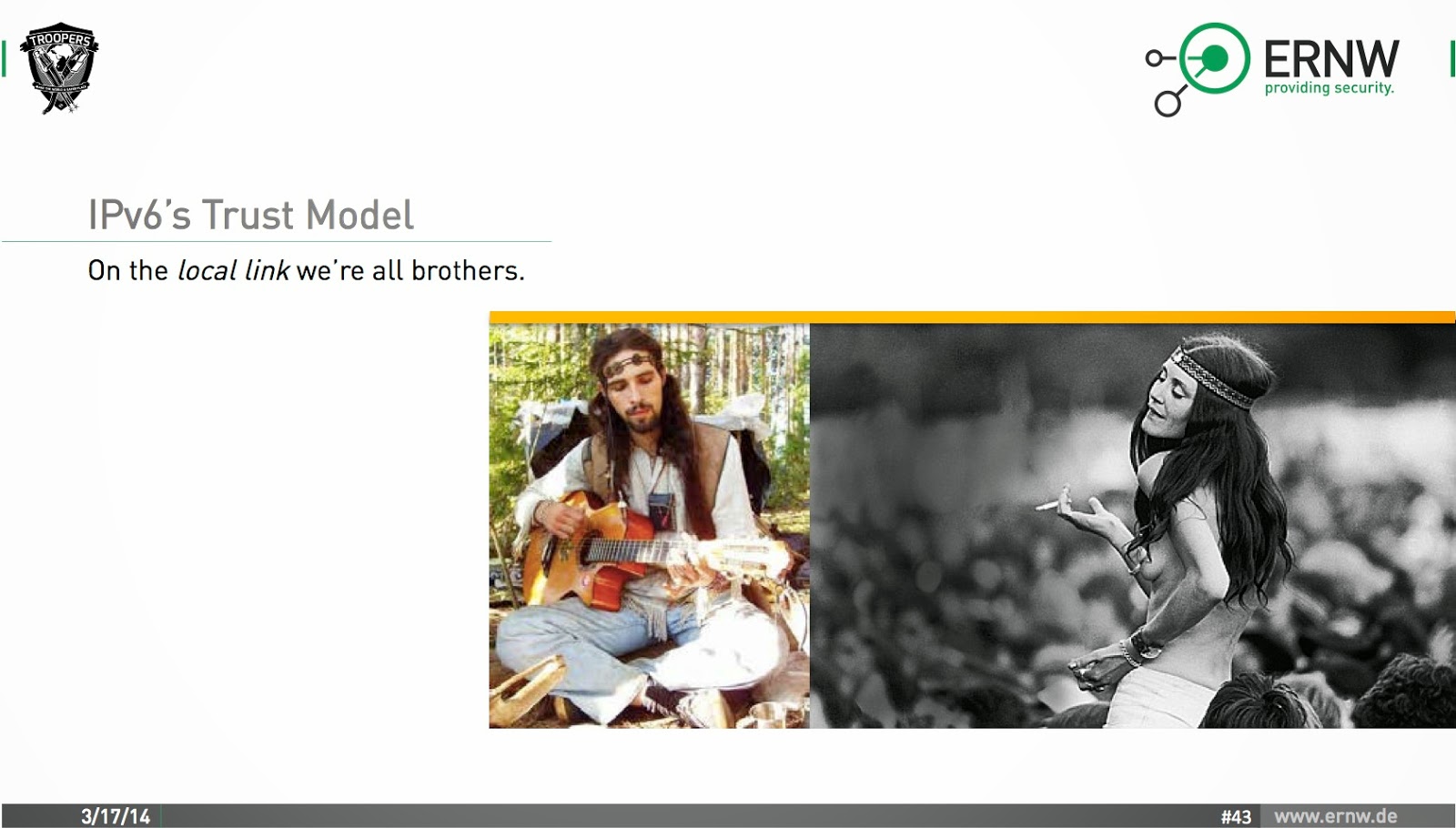The Hierarchy of Isolation
Friday roundtables are one of the best parts of the Troopers conference – this year we were busy discussing (among other things) how safe the hypervisors are as compared to more traditional network isolation paradigms.
TL&DR summary: If someone manages to break into your virtualized infrastructure, he’ll probably find easier ways to hop around than hypervisor exploits.
Security and SDN
I don’t think it would be too hard to guess the topic of my talk at the recent Troopers conference: SDN was the obvious choice, and the presentation simply had to include security aspects of SDN.
TL&DR summary: We know how to do it. We also know it's not simple.
Quantum SDN
An interesting startup is launching their SDN solution @ Interop Las Vegas today: Quantum Networks use the latest quantum computing technology to solve some of the hardest problems of controller-based networking.
One of the fundamental problems of hardware-based OpenFlow solutions is the flow update rate – most switches using merchant silicon can insert around 1000 new flows per second into their forwarding tables. Technologies based on quantum mechanics effects change all that – a quantum entanglement technology patented by Quantum Networks can install new flows instantaneously across the whole network.
STP in Brocade VCS Fabric – an Interesting Solution after a Long Wait
A few years ago I lambasted the lack of STP support in Brocade’s VCS fabric. It took Brocade over two years to solve the problem, but they finally came up with an interesting end-to-end solution.
Here are a few highlights; for more details read the Configuring STP-type Protocols section in Network OS Administrator Guide.
IPv6-Only Data Center Deployment
Last June Tore Anderson talked about his IPv6-only data center deployment (the idea made very popular recently after Facebook’s presentation @ V6 World Congress) in one of my free webinars. In case you missed the videos explaining the technical details, watch them or view Tore’s slide deck.
What Happened to “Be Conservative in What You Do”?
A comment by Pieter E. Smit on my vSphere Does Not Need LAG Bandaids post opened yet another can of worms: vSphere behavior on uplink recovery.
Short summary: vSphere starts using an uplink as soon as its physical layer becomes operational, which might happen during ToR switch startup phase, or before a ToR switch port enters forwarding state.
Facebook Is Close to Having an IPv6-only Data Center
Whenever I mention the idea of IPv6-only data centers, I get the usual question: “Sounds great, but is anyone actually using it?” So far, my answer was: “Yeah, I know a great guy in Norway that runs this in production” As of last week, the answer is way more persuasive: “Facebook is almost there.”
Thank you, Troopers!
I spent the whole last week immersed into security-spiced atmosphere of Troopers, a fantastic boutique security conference (like last year, they limited the number of attendees and sold out weeks before the conference).
I admit they totally spoiled me last year, but they managed to make the conference and all the accompanying events even better.
Real-life OpenFlow Deployments
Talking about OpenFlow (and poking holes in it) is fun, but are there any real-life deployments (apart from highly-publicized Google’s internal network)? I tried to describe a few of them in my SDN 101 webinar.
Microsoft is using tap aggregation network in production, and I forgot to mention OpenFlow-based New Zealand IXP.
Cisco IOS Supports RFC 6106 (RDNSS)
When Enno Rey mentioned RFC 6106 support (why does it matter?) on Cisco IOS during the opening presentation of Troopers 2014 IPv6 security summit I got interested but remained a bit skeptical. When Eric Vyncke (sitting in the audience) started nodding, I knew it must be there. Finding the feature in IOS documentation turned out to be mission impossible.
Per-packet Load Balancing Interferes with TCP Offload
A reader left the following comment on my Does Multipath TCP Matter blog post: “Why would I use MP-TCP in a data center? Couldn’t you use packet spraying at each hop and take care of re-ordering at the destination?”
Short answer: You could, but you might not want to.
We’re All Brothers on Link-Local
I was listening to excellent opening presentation Enno Rey had at Troopers 2014 IPv6 security summit (he claimed he was ranting, but it sounded more like some of my polite blog posts) and when I’ve seen this slide I could literally hear a blog post clicking together in my head.

In short: IPv6 has many shortcomings, but this might not be one of them.
Scaling BGP-Based DMVPN Networks
Cristiano sent me an interesting question:
I saw that to configure BGP as the routing protocol running over DMVPN I have to configure BGP neighbors on the hub site router. Do I really have to configure all the neighbors on the hub site? How many neighbors could I configure? How can I scale that?
According to Cisco Live presentations, BGP-over-DMVPN scales to several thousand spoke sites (per hub router), so you shouldn’t be too worried about the protocol scalability. Configuring all those neighbors is a different issue.
The Fundamental Problem of IT Industry
The best description of fundamental problems of IT industry I found recently comes from @cloud_borat. Evidently SDN is no different.
Scale-Out Load Balancing with OpenFlow
When OpenFlow was still fresh and exciting, someone made quite a name for himself by proposing a global load-balancing solution that would install per-session OpenFlow entries in every core switch around the world. Clearly a great idea, mimicking the best experiences we had with ATM SVCs.
Meanwhile some people started using OpenFlow in real-life networks for coarse-grained load balancing that improves the scalability of stateful network services. For more details, watch the video recorded during the Real Life OpenFlow-based SDN Use Cases webinar.
